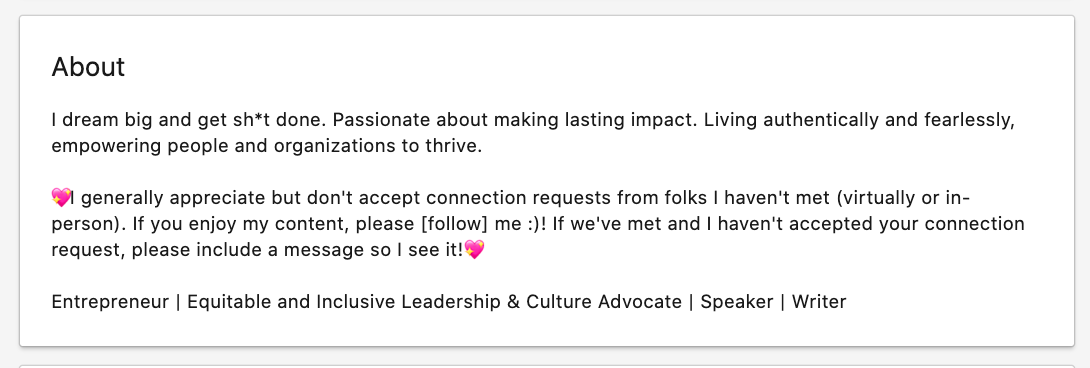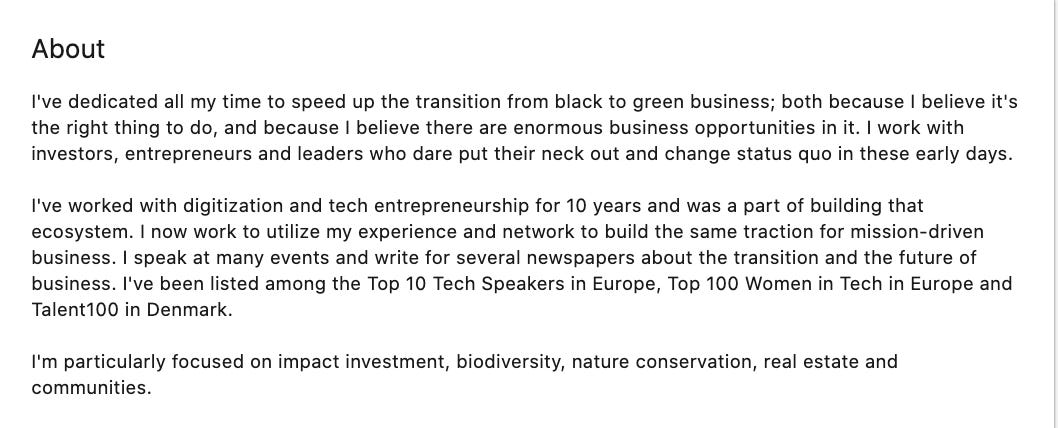How to create a personal brand for a successful career. Career Crossroads challenge #2
What a personal brand can do for you, and how to rock yours on LinkedIn.
Hello all,
Today marks Week 2 of the Career Crossroads challenge. You can catch up on what that is exactly by reading here and you’ll find week 1’s post here.
This weeks' question is one I am passionate about and know from conversations it’s one you have many questions about: personal branding.
PS if you’re new here, The Ask covers in-depth answers to commonly asked career questions each week. Get involved!
To begin, a definition...
Personal branding is what you are known for.
It’s the impression that others have of you, what they would contact you regarding or might pay you to do for them.
Whilst the name personal infers it’s all about you, it’s also about what others think of you. Sorry.
Rarely as a coach will I encourage you to over-index on other peoples' opinions, but in this case we have to. It doesn’t matter what you think of you here if others don't.
Should someone exclaim to you, "You're the person who does X" and that is what you want to be known for; congratulations, your personal brand is working on your behalf. If they get it wrong, your personal brand may be out of sync.
A personal brand should be the combination of your skills, strengths, experiences, passions, and causes you care about. It should speak to the impact you have driven to date or can drive in the future.
It can be tangible, for example through a metric like a "30 under 30 list" or it can be intangible; a feeling or energy that someone gets from you.
Any associations that people draw from you constitute a personal brand.
Whilst you cannot control other’s opinions entirely, we can at least influence them. We can project the version of ourselves that we aspire to be. We can use our goals, dreams, and hopes as an anchor point and build an image of ourselves around these things.
Think of personal brand as signaling.
Signaling is what is done by luxury brands, to encourage you to splash the cash. Its what you pay advertising execs to do for your business. Its the line that waits overnight outside the trainer shop for the coveted new pair.
Signally doesn't happen on its own.
A personal brand is intentional, and it stems from having a purpose.
If you want to be intentional about the image you are portraying, it should reflect the image that is important to you.
What is important to you right now? Securing a new job? Speaking gigs? Finding customers? Saving the planet?
Connect to your purpose, your why, cause and mission, and let your personal brand flow from there.
For today’s newsletter, we are focusing on personal brand in the context of online profiles, predominantly LinkedIn.
Google is your CV in today’s world.
If you search your full name, your LinkedIn is likely to be one of the first hits. With 610 million members and 80% of businesses generate their leads here, it pays to invest in this channel for a successful career or business.
So let’s get into it.
P.S. if you’re on the Career Crossroads challenge, make sure you have done your Career Review before this exercise. The learnings you’ll get from that will inform what you portray on your profile.
There are some general principles and rules for your online profiles that I’ll go into now.
But to ensure you take action and not just learn about it, you can grab your Your Template for a Killer LinkedIn here.
So how to create a personal brand for a successful career, I hear you ask.
Have goals
Before you embark on your personal brand strategy, start with the end in mind.
As I alluded to above, you need a reason for this. Think about the doors you want your personal brand to open.
If you need a helping hand with goals you can read about setting meaningful career goals and we touched on goals for networking in this post here.
Be relatable
This is my big hint for people trying to make a splash in a field that isn’t super corporate (e.g. law, banking, medicine). Which since that isn’t many of you here, being relatable is one for you.
People buy people. Whilst it’s your professional profile that doesn’t mean it has to be dry. Inject some personality, write colloquially, and share what you care about.
The best profiles showcase their skills but also what makes them tick. They make you want to get to know someone, which, lets’ face it if you’re being hired or to deliver a service you’re going to be interacting with people and need to get along with them. Show them up top what you’re going to be like to work with and you might make that sell a little easier.
Here’s Dan - he’s an incredible Head of People. I helped Dan with a coaching session before he landed this job, he’s doing incredibly well and his profile makes you want to get to know him on a personal level too.
Have a read for yourself:
Dan has included loads of ways you could hope to connect with him - gym, food, travel, creative writing? Go for it. He’s gone first and now you can relate to him.
Get social
This one is for LinkedIn but also important for the other channels too like Instagram or Facebook. If you’re trying to gain attention to your profile, the algorithms reward people who interact with others (social media, duh). So go ahead message people, but keep it personal! Here’s the networking post again for tips about the best way to approach people online.
Be succinct
I don’t care how interesting you are, no one wants to read war and peace on your profile. Keep it high level and snappy. Less is more here - remember the LinkedIn profile is NOT your CV. Your CV is for the detailed achievements you have, responsibilities outlines and all your grades etc. LinkedIn is the highlight reel, leave them wanting more.
Another reason not to copy-paste the CV onto LinkedIn is that it makes it super obvious you’re job hunting. This isn’t necessarily a good thing even if you are. Wait for next week’s post about job applications and recruiters for more info here.
The CV can be 2 pages of A4 so if it were on A4, image the LinkedIn being about half of this.
As a general rule of thumb, your most recent experiences should be the most padded out in terms of detail, and the older experiences less so. If you’ve got a 20-year career I’m only really interested in the last 10 years, no need for descriptions on those roles before then. If you’re newer in your career, say 3-5 years it’s ok to include some pre-Uni work experience (if you had any) but ONLY if its impressive and for a decent time span. That one-week internship? Leave it out. The summers you spent working in restaurants? Leave it out.
You’ll have to use your own judgment here but generally, the key is to only include things that are pointing towards your future. Personal branding should project the image of where you are going, it’s less about where you’ve been.
Fill in the blanks
Is LinkedIn suggesting you add a section? Follow it. They boost profiles that are completed.
Make sure the companies you’ve worked at have been linked to correctly. Nothing looks worse than the empty grey square. It could be the best company in the world and I won’t believe you because I can’t click on it. Also if you can always write what you do at that company, not just what the company does. More tips like this on the Your Template for a Killer LinkedIn.
We will judge a book by its cover
That book is you, and that cover is your profile photo. Keep it professional, on your own (shouldn’t need to be said but you’d be surprised), lighting and angles on point and in clothing that reflects your goals. Dress for the job you want not the one you have :)
Use the headline & summary
The SEO (how Google ranks things) will focus in on what you write in your Headline and your Summary. Examples below.
If you want specific things, this is where you really bring them to the fore. Pick 1-3 things though, do not spam this with random keywords!
Anouk who runs an amazing people consultancy for corporates has done this well. She’s even separated the keywords out so that humans know that they don’t need to focus too much here, but the robots pick up on it! She has led with a punchy, personal summary though to create trust.
Don't be afraid
I know this sounds like a lot of rules, but really you can't get it wrong. It’s your life.
It’s also ok to set boundaries and tell people what you don’t want. Michelle has diplomatically stated her rules of engagement for new connections. She says she is living authentically and fearlessly, and then demonstrates straight away one way she’s living this truth. I love it.
Curate your feed/connections
Much like Michelle has just shown us, it’s fine to keep people out to make way for others in. If you’re a designer working with brands, there’s not a problem keeping your network exclusively for other designers and brand owners, for example. The random people who add you to sell to you don’t have to be in your network if you don’t want them to be. Personal branding is as much about what conversations you’re exposed to as the ones you’re starting. If you only add or follow relevant people your feed is likely to support your learning and networking goals that much better.
Keep your personal life private
If you’re actively job-hunting and haven’t been using your social profiles in a professional context, you’re better off with them private. The photos of nights out and so on are likely to do more harm than good.
If you use these profiles in a professional context, carry on, just select what needs to stay and what needs to go.
Invest in the right tools
If you’re creating an online profile off LinkedIn, be it a CV or domain eg yourname.com then it is worth investing in tools or software that puts your best foot forward.
Sometimes I’ll see a CV that is in a template I’ve seen many others use (its the only free one on the website) and it’s a turn-off. Or the pixels are blurry. Pay the $10 or whatever it is and get a brushed up one that suits your style and stands out for good reasons.
Tell stories
Telling stories about projects you’ve worked on is a great tip in interviews, to cement you in the interviewers’ memory. It’s also good to do it on your profile, in your posts and in the conversations you’re creating. People want to be entertained and inspired — you could be that person.
Share what you care about
The causes you care about are key for your personal brand. They help people place you mentally, but they also help you stand out. Passionate people are interesting and create hype.
Compare two people with the same skill set but one of them is a passionate Diversity & Inclusion advocate. If you’re the hiring manager, you are more likely to call back the person with interests and networks that will paint their company in a good light if they hire you.
Tine has done a great job of highlighting her passion for green business. She’s promoted this cause alongside other relevant professional achievements. You know you’d be collaborating with an entrepreneur with a track record, who also happens to have this important mission behind her.
Hype yourself
You have to promote yourself to stand out. You have to put yourself forward for opportunities, be it a role, speaking opp, media coverage, or whatever. This is chicken and egg as you need a brand to land these things, but having these things will help build your brand.
The best way to hype yourself before you have conversation-worthy achievements to speak of, is to hype others, and share opinions, or write about interesting things in your industry. Eventually, you’ll be the one featured — then you can promote your post!
I loved seeing this from Bill Dawden on my feed. I don’t know Bill but someone I do know liked it so it popped up on my feed. It just goes to show how sharing any win can put you in front of people who may help you in some way.
Side note.. I’ve been hyping the event I’m running tomorrow - How to Beat Your Inner Critic - for the last couple of weeks. It can feel difficult to keep pushing the same message but you’d be surprised how many people miss your posts. So here it is again, 24 hours to go and this is one for people who finally want to let go of their inner saboteur, perfectionist or negative voice when starting something new! Grab a ticket now!
Craft your LinkedIn now
Your Template for a Killer LinkedIn outlines the exact steps you need to take to implement some of these tips I’ve listed above, and more.
Would you like to be featured in a ‘Profile of the week’ section I’ll be adding to the newsletter soon? Share what you’re working on, looking for, and who you’d like to connect with and we can boost your engagement. Just email me privately if so.
That’s it for today. Career Crossroads challenge participants will receive the LinkedIn template to make some changes to their personal brand over the next week and I’m so excited to see the results.
Stay tuned for next week, I’ll be dishing the dirt on recruiters (I’ve been one for 7 years) and what they look for, as well as some tricks to follow in the application process.
If you want to make someone’s day who’s looking for a job, do them a favour and share this before next week.
What is The Ask Newsletter?
As Chief Coach & Founder of The Ask I write this newsletter to answer commonly asked questions across careers, personal development, mindset, and entrepreneurship. Delivered to your inbox weekly every Wednesday.










